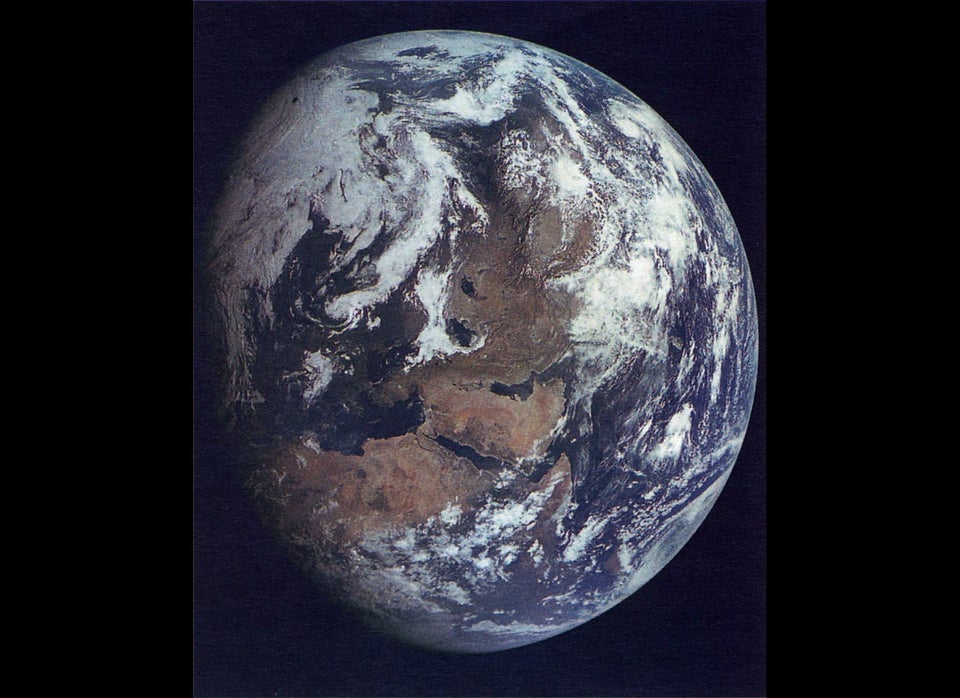Do you remember learning about Pangaea in school? It was the last great supercontinent, and it existed from about 300-200 million years ago. I remember doing a "geography fair" project on Pangaea in the fifth grade (and taking home a blue ribbon). I think that's the last I ever thought about continental drift, to be completely honest.
So when I read about a new supercontinent, Amasia, that's theorized to form sometime in the next 50-200 million years, my ears perked up. I suppose it never occurred to me that the continents are still drifting and will continue to do so in the future.
The theory of plate tectonics--a description of large-scale movements of the Earth's crust--is relatively modern, having come into the public consciousness as late as the 1960s. Today, scientists are applying their understanding of continental drift (via plate tectonics) not only to reconstructions of the continents of ancient Earth, but to predictions of future Earth.
I spoke with Ross Mitchell, a graduate student at Yale University, about his new model for the next great supercontinent, Amasia. To learn more, watch the video above or click the link below. And don't forget to leave a comment at the bottom of the page. Come on, talk nerdy to me!
CARA SANTA MARIA: Hi everyone. Cara Santa Maria here. Have you ever heard of the continent Amasia? That's probably because it hasn't made it's way to our maps quite yet. See, in 50 to 200 million years, there won't be an Africa, Asia, Europe, or America. There will only be Amasia. It's the next great supercontinent, like Pangaea was until 200 million years ago. See, continental drift isn't just the stuff of history books, it's the future of our planet too, and it's happening right now, before our very eyes.
ROSS MITCHELL: It’s actually a remarkable time to be alive in the sense that we can very much look into our past and see the visages of Pangaea, you know we can easily imagine closing the Atlantic Ocean and juxtaposing this jigsaw arrangement of continents and we can also realize that new continents are being made. In fact, I mean, you look at Himalayan range with India converging with Asia in the last 50, 60 million years and we see mountains actively being built. So we look into the past and we see the past supercontinent and we look in the future and see the future supercontinent, we’re kind of in the middle of a cycle.
CSM: That's Ross Mitchell, a doctoral student in geology and geophysics at Yale. We talked about how the things we think of as fundamentally permanent, like the ground beneath our feet, are always in flux. How the tectonic plates that make up the Earth's crust are always in motion, forcing the continents to wander. And how looking into our geologic past is teaching us what the future holds. For his dissertation, he developed a new model of the next great supercontinent, Amasia.
RM: So our new model for the formation of supercontinents, which allows us to project, kind of speculatively into the future, allows us to predict that the future supercontinent Amasia will take form at the North Pole, closing the Arctic Ocean and the Caribbean Sea, fusing the Americas together and then the Americas with Eurasia, hence the name Amasia.
CSM: He calls this model orthoversion, as opposed to the previously existing extroversion and introversion models. See, the first theory of a new supercontinent proposed that the land masses as we know them today would continue to spread outward from their original positions in Pangaea until they finally came back together on the other side of the globe, closing the Pacific Ocean. Hence, extraversion.
RM: The introversion model you know quite frankly couldn’t have been more opposed. They said that instead of the Pacific Ocean vanishing and the future supercontinent, instead of the supercontinent turning itself inside out, what if a supercontinent collapsed back in on itself?
CSM: So in the introversion model, Amasia would be kind of similar to Pangaea. But in Ross's orthoversion model, he theorizes that Amasia will come together around the North Pole.
RM: Even though plates and continents are drifting inextricably and constantly, it’s a very slow drift. I mean we’re talking millimeters, centimeters per year. This is the rate our fingernails are growing, to put that in context. And so Pangaea, which is the latest most famous supercontinent, took form about 300 million years ago, but before Pangaea we have evidence for, good evidence for, two supercontinents before Pangaea. Pangaea was 300 million years ago. Before Pangaea, we have Rodinia, which took form about 1 billion years ago and before Rodinia, we have about 2 billion years ago there’s Nuna.
CSM: What an incredible thing, to know the very land where our feet are so firmly planted was once thousands of miles away. Our evolutionary past was shaped by the dramatically different landscape of the supercontinents, where all life thrived together, before it was pulled apart into lonely islands, only to repeat the process again and again. And if our species continues to flourish, one day, we will all be citizens of Amasia. Alright everyone, you know the drill. Sound of on Twitter, Facebook, or leave a comment right here on The Huffington Post. Come on, talk nerdy to me!
See all Talk Nerdy to Me posts.
Like Cara Santa Maria on Facebook.
Follow Cara Santa Maria on Twitter.
